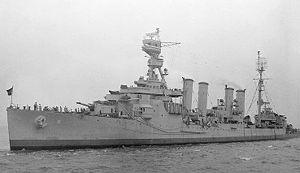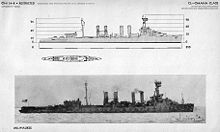- Omaha class cruiser
-

USS Milwaukee (CL-5), an Omaha class cruiser.Class overview Name: Omaha class cruiser Operators:  United States Navy
United States NavyPreceded by: Chester-class cruiser Succeeded by: Brooklyn-class cruiser Planned: 10 Completed: 10 Scrapped: 10 General characteristics Type: Light cruiser Displacement: 7,050 tons Length: 556 ft 6 in (169.62 m) Beam: 55 ft 4 in (16.87 m) Draft: 20 ft 0 in (6.10 m) Speed: 35 knots (65 km/h) The Omaha-class cruisers were a class of light cruisers built for the United States Navy. The oldest class of cruiser still in service with the Navy at the outbreak of World War II, the Omaha class was an immediate post-World War I design.
Maneuvers conducted in January 1915 made it clear that the US Atlantic Fleet lacked the fast cruisers that were necessary to give information of the position of the enemy as well as to deny the enemy information of our position and to screen friendly forces. Built to scout for a fleet of battleships, they featured a high speed (35 knots) for cooperation with destroyers, and 6 inch (152 mm) guns to fend off any destroyers the enemy might send against them. Displacing 7,050 tons, they were just over 555 feet long.
The Omaha class was designed specifically in response to the British Centaur-class cruisers. Although from a modern viewpoint, a conflict between the US and Great Britain seems implausible, US Navy planners during this time and up to the mid-30's considered Britain to be a formidable rival for power in the Atlantic, and the possibility of armed conflict between the two countries plausible enough to merit appropriate planning measures.
Due to their age, the Omaha class mounted four smokestacks, a look remarkably similar to the old four-stacker destroyers. Their armament showed the slow change from casemate-mounted weapons to turret-mounted guns. They held a full twelve 6"/53 caliber guns, of which four were mounted in two twin turrets, one fore and one aft, and the remaining eight in casemates; four on each side. Launched in 1920, the USS Omaha (designated C-4 and later CL-4) had a displacement of just over 7,100 long tons. The cruisers emerged with a distinctly archaic appearance owing to their World War I-type stacked twin casemate-mount cannons and were among the last broadside cruisers designed anywhere.
As a result of the design changes placed on the ship mid-construction, the Omaha that entered the water in 1920 was a badly overloaded design that, even at the beginning, had been rather tight. The ships were insufficiently insulated, too hot in the tropics and too cold in the north. Sacrifices in weight savings in the name of increased speed led to severe compromise in the habitability of the ship. While described as a good ship in a seaway, the low freeboard led to frequent water ingestion over the bow and in the torpedo compartments. The lightly built hulls leaked, so that sustained high-speed steaming contaminated the oil tanks with sea water.
These drawbacks notwithstanding, the US Navy took a great deal of pride in the Omaha class. The Omaha placed a high emphasis on underwater explosion protection from the threat of torpedoes. She was designed with improved compartmentalization while her magazines were the first to be placed on centerline, below the waterline.
Originally designed to serve as a scout, they served throughout the interwar period as leaders of fleet flotillas, helping them resist enemy destroyer attack. Tactical scouting became the province of cruiser aircraft, and the distant scouting role was taken over by the new heavy cruisers spawned by the Washington Naval Treaty. Thus, the Omahas never performed their designed function. They were relegated to the fleet-screening role, where their high speed and great volume of fire were most appreciated.
Due to the large topweight lasting on these ships, compounded by the high-mounted catapults, the Navy removed the two lower aft firing casemate-mounted 6 inch guns in 1939, fairing over the casemates port and starboard.
These were the oldest class of cruisers still in service with the Navy in 1941.
Contents
Omaha Class Ships
"U.S. Navy Cruisers 1940-1945". http://www.ibiblio.org/hyperwar/USN/ships/ships-ca.html. Retrieved 18 September 2011.
- CL-4 USS Omaha Launched 24 Feb 1923
- CL-5 USS Milwaukee Launched 20 Jun 1923
- CL-6 USS Cincinnati Launched 1 Jan 1924
- CL-7 USS Raleigh Launched 6 Feb 1924
- CL-8 USS Detroit Launched 31 Jul 1923
- CL-9 USS Richmond Launched 2 Jul 1923
- CL-10 USS Concord Launched 3 Nov 1923
- CL-11 USS Trenton Launched 19 Apr 1924
- CL-12 USS Marblehead Launched 8 Sep 1924
- CL-13 USS Memphis Launched 4 Feb 1925
Omaha alternatives
The U.S. Navy was not entirely pleased with the Omaha class, so a new design was drawn up that was based on the Omaha class.[citation needed] This new class replaced all of the Omaha's 6 inch guns with 4 turrets (2 forward, 2 aft) each with two 6 inch guns.
Two other Omaha versions were also designed. The first, intended to function as monitors, had two 14 inch guns in 2 single turrets, while the other design had four 8 inch guns in 2 twin turrets. The latter design eventually evolved into the Pensacola class cruiser.
See also
 Media related to Omaha class cruiser at Wikimedia Commons
Media related to Omaha class cruiser at Wikimedia CommonsExternal links
- http://www.avalanchepress.com/OmahaAlternatives.php
- http://www.avalanchepress.com/AmericanCruisers.php
Omaha-class cruiserOmaha · Milwaukee · Cincinnati · Raleigh · Detroit · Richmond · Concord · Trenton · Marblehead · Memphis
Preceded by: Chester class - Followed by: Brooklyn class
United States naval ship classes of World War IIAircraft carriers Light aircraft carriers Escort carriers Battleships Large cruisers Heavy cruisers Light cruisers Destroyers Destroyer escorts Patrol frigates Minesweepers Submarines - S — Single ship of class
- C — Completed after the war
- X — Cancelled
Categories:- Cruiser classes
- Omaha class cruisers
- World War II cruisers of the United States
Wikimedia Foundation. 2010.

